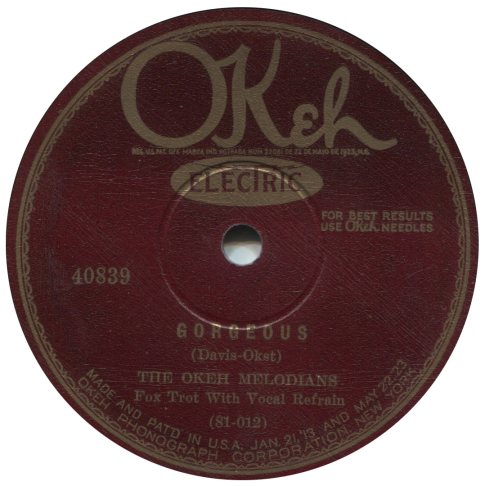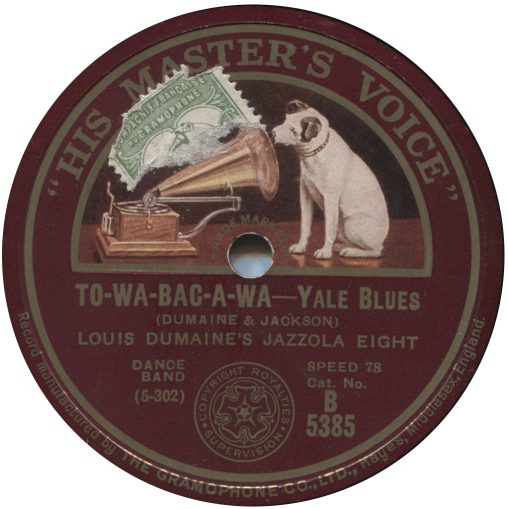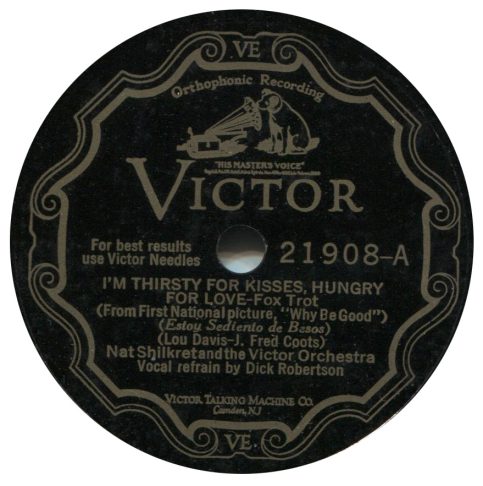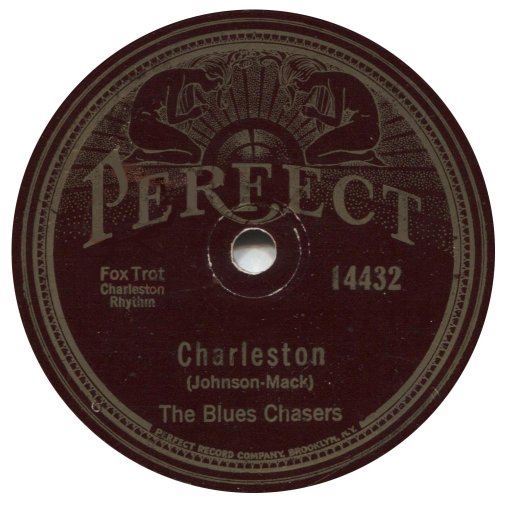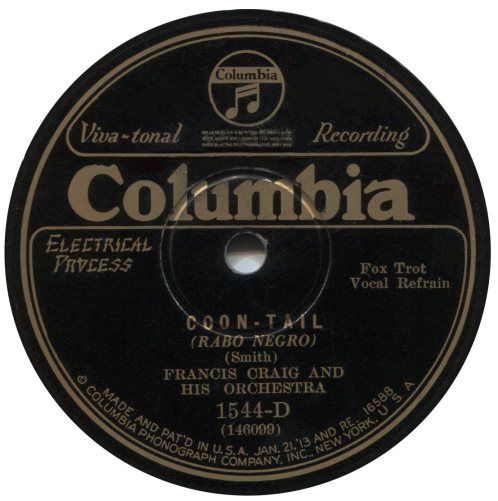
Background information about the recordings can be found below the audio selections.
“Coon-Tail”
Francis Craig And His Orchestra
(Columbia 1544-D mx 146099) April 16, 1928
“Red Rose”
Francis Craig And His Orchestra; Billy Scott
(Columbia 1544-D mx 146098) April 16, 1928
This record, from the Edward Mitchell Collection, is among the strangest jazz/dance band records I have come across.
I’m not the only one with that opinion. Here is how the November 1928 edition of The Phonograph Monthly Review described it while reviewing Columbia’s latest dance records:
“…an odd record by Francis Craig, Coon-Tail and Red Rose (1544-D). The latter glorifies in jazz MacDowell’s celebrated wild rose, which, needless to say, grows somewhat wilder still in dance form. Coon-Tail is an exceedingly strange piece with many changes of pace, a veritably lovely smooth middle section, and peculiar ending.”
The Francis Craig Orchestra was based in Nashville, Tennessee. 1925 was a particularly auspicious year for Craig and his band, as they began an engagement at the Hermitage Hotel, an association that would last over 20 years.
That same year, the band also made the first of four trips to Atlanta for a date with Columbia’s mobile recording equipment as part of the company’s regular field trips to record regional talent.
On October 5, 1925, Craig’s band performed on the initial broadcast of radio station WSM, which was owned by two of his uncles and managed by a cousin. WSM’s powerful signal and the band’s regular broadcasts from the Hermitage Hotel made Craig regionally famous, eventually becoming known as the “Dean of Southern Maestros”.
Several entertainers who went on to become famous had early jobs with Craig’s band, including James Melton, Irene Beasley, Kenny Sargent, Phil Harris, Snooke Lanson, Kitty Kallen, and Dinah Shore.
The record featured here was the last Craig would make for almost 20 years. Then, in 1947, when the dance band industry was in steep, irreversible decline and Craig was preparing to wrap up his career, he recorded two sides for an obscure local record label. To everybody’s surprise, it became a huge hit and spent an unprecedented 17 weeks at the top of the music charts, a record that stood for over 50 years. It not only resulted in sudden national fame for Craig, it also helped put Nashville, which today is widely known as “Music City,” on the musical map.
The Phonograph Monthly Review’s description of “Coon-Tail” as “exceedingly strange” is, in my opinion, spot on.
The strangeness begins the moment one looks at the record label, which describes the song as “Fox Trot – Vocal Refrain.” Yet nowhere during the recording is there any sort of vocal.
Then there’s the unusual title “Coon-Tail.” I did quite a bit of digging to find the title’s intended meaning, and came up empty.
A websearch for the terms “coon tail” and “coontail” turned up a few possibilities, including one that is rather unpleasant. But none of them strike me as strong enough to form the basis of a good guess.
The song was composed by J. Bradford Smith, who worked for Craig as a trombonist and arranger in the late 1920s and early 1930s.
A column in the April 28, 1928 issue of The Billboard referred to the recording session this record is from and provided a listing of the band’s roster at the time:
Francis Craig and his orchestra have just finished recording four sides for Columbia. In the Craig lineup are Francis Craig, piano and director; Charles Nagy Jr., violin; Herbert Guy, Rolly Thatcher and Cecil Bailey, reeds; Billy Scott and Malcolm Crain, trumpets; Bradford Smith, trombone and arranger; Powell Adams, drums; Max Hart, banjo and guitar; and Jack Hamilton, bass.
In 1930, when Francis Craig contracted tuberculosis and spent a year recuperating in a Denver sanitarium, J Bradford Smith filled in as the band’s leader. He left the band sometime around August 1931.
Smith’s November 2, 1928 copyright registration for “Coon-Tail” describes it as “melody with pianoforte accompaniment” and lists Nashville as his location. It also indicates that the song was unpublished, which, since there was no US federal copyright protection for sound recordings at the time, means that it was not printed and made available for public purchase in sheet music form. The copyright listing makes no mention of any lyrics that might provide a clue to the title’s meaning – and given the nature of the song, I don’t know how anyone could set lyrics to it.
Among the possible sources of inspiration for the song’s title is a species of aquatic plants that is sometimes referred to as “coontail” or “coon’s tail.” But period and cultural references to the plant are sparse, which suggests to me that it’s an unlikely guess.
The western diamondback rattlesnake is sometimes referred to as a “coontail rattlesnake.” But the snake’s natural range is nowhere close to Nashville, so it’s difficult to imagine the band’s core audience being familiar with such a reference.
A more likely possibility is that it is a reference to the tail of a raccoon, particularly in the context of the tail hanging from a coonskin cap, which is traditionally associated with Tennessee and surrounding states.
Another possibility is the then-widely advertised “Ball Band Coon-Tail” boot, made by Red Ball, a company that manufactured rubber boots. Their “Coon-Tail” boots featured a knit wool upper portion which, based on drawings in period advertisements, was striped and resembled the markings on a raccoon’s tail.
Finally, given the cultural attitudes of the time, one can’t rule out the possibility that it might be a reference to an extremely disparaging ethnic slur against black people. During the 1900s and into the 1910s, countless recordings of “coon songs” ridiculing blacks were issued. By 1928, however, while racism was still pervasive and deeply institutionalized, the popularity of “coon songs” had mostly died out and new recordings of that genre had become rare.
What gives some credence to this being a possibility is the label’s Spanish translation of the title as Rabo Negro – which translates to “black tail.” Such translations were often provided on records that US-based labels intended to market in various Latin American countries. I was not able to find any reference through online translation tools to Spanish words that in any way equated “black” with either “coon” or “raccoon.” That suggests, to me, that whoever made the translation likely did intend for the word “coon” to refer to the racist slur.
But, even if so, I don’t think it necessarily reflects what J. Bradford Smith or Francis Craig intended for it to mean. It is highly doubtful that either Smith or Craig would have been asked to provide a Spanish translation for the titles of the songs they recorded. Most likely, such translations were the responsibility of someone in whatever department prepared the label text for a given release. Perhaps it was an older, long-time employee who had been with Columbia since the days when “coon song” records were still being widely issued and reflexively assumed that same context when he saw the song’s title. Or perhaps it was just the same genius who placed “vocal refrain” on the label when the recording, in fact, has no vocal.
Regardless, when it comes to instrumental songs, titles don’t matter all that much. What counts most is the music itself. And that’s where the record becomes even stranger.
The song consists of a hodgepodge series of seemingly unrelated musical passages and, to use The Phonograph Monthly Review’s words, “with many changes of pace… and peculiar ending.”
It also contains multiple snippets of musical quotes referencing other well-known compositions. I counted four such compositions, and there may be others that I did not pick up on.
Between 1:17 and 1:25, one can hear passages that sound very similar to those in Rube Bloom’s 1927 composition “Soliloquy.”
Beginning at 1:31, one can hear brief snippets that are clear references to George Gershwin’s “Rhapsody in Blue” and another one at 2:03.
Starting at 2:15, one can hear “Tiger Rag” and, at 2:30, the jazz standard “Copenhagen.”
The recording is, in no way, unpleasant to listen to – but it is….strange.
To add a further mystery to the record, I came across a mention in a local Nashville newspaper about the recording session it is from.
During that recording session, the Francis Craig band recorded two additional selections, “Dream River” and “All Day Long,” both of which were issued on Columbia 1440-D.
The following appeared in the April 15, 1928 Nashville Tennessean:
Francis Craig and his recording orchestra has just returned from a trip to Atlanta where they made four records, the selections recorded being “All Day Long,” “Green River [sic],” “Dinah” and “Red Rose”….
That this was in the April 15 edition of the paper is interesting, as both Brian Rust’s American Dance Band Discography and the Discography of American Historical Recordings (D.A.H.R.) list the recording session as taking place on April 16.
Moreover, neither discography makes any mention of an unissued take of “Dinah” having been made – something they usually do. And the newspaper makes no mention of “Coon-Tail” having been recorded.
D.A.H.R also, by the way, incorrectly lists the recordings as having been made in New York City. But that is incorrect, based not just on the evidence already covered here, but also on its own listings of the matrix numbers of the recordings immediately before and after Craig’s April 16 titles, which state that they were recorded in Atlanta on the same day. An entirely different block of matrix numbers would have been used for recordings made that day in Columbia’s New York studios.
If I were to venture a guess about the recording’s strangeness, it would be based on the fact that Craig’s band did not just perform popular music and jazz during this period. It also performed concerts of classical music and accompanied local theatrical productions. During that period, popular bands would sometimes perform “concert-style” jazz arrangements intended for “highbrow” audiences in venues where one might typically hear classical music, rather than audiences looking for jazzy music they could also dance to. Paul Whiteman’s band, in particular, was well-known for recordings of that genre. “Coon-Tail” strikes me as an attempt in that direction.
But, if so, what is odd here is that “concert” style recordings were usually marketed and clearly labeled as such, and were often issued on 12-inch rather than 10-inch records, and frequently sold for a higher price. But this recording was labeled as a “fox trot” and was offered as part of the same catalog number series as any other Columbia dance band release. Any buyer looking for a typical dance record was definitely in for a surprise when they returned home and placed it on their phonograph.
One possible explanation that occurs to me is that the original intent of both the band and Columbia was for the recording of “Dinah,” mentioned in the newspaper article, to be included with the other three songs recorded that were eventually issued. Perhaps “Coon-Tail” was something recorded to either humor the band or maybe as a de facto audition for Columbia executives in New York for possible future recordings of that ilk. This record was issued about three months after the other record from that recording session. Maybe there was some concern in New York about the recording made of “Dinah,” or maybe someone really liked “Coon-Tail” and a decision was made to issue it instead.
Should I come across any additional information about the intended meaning of the “Coon-Tail” title or the recording of “Dinah” that is not mentioned anywhere else, I will update this posting accordingly.
“Red Rose, ” based on Edward MacDowell’s 1896 “To A Wild Rose,” was composed by Francis Craig in 1928 and dedicated to his wife. Craig used “Red Rose” as the theme song on his band’s WSM broadcasts, and thus it became well-known in Nashville and throughout the South.
In 1947, when the popularity of dance bands was rapidly fading, Craig was preparing to retire from his many years at the Hermitage Hotel. He was approached by the owner of a small, local label, Bullet Records, to make another recording of “Red Rose.” Craig agreed to do so but needed to find a song for the record’s B-side.
The particular choice of song for the B-side was not regarded as extremely important, as the marketing of the record was to be strictly based on the fame of “Red Rose.” Craig chose a tune that he had written called “Near You.” Previously, during a visit to Nashville, lyricist Kermit Goell met up with Craig at the Hermitage Hotel’s restaurant. Craig sounded the tune out on a piano and mentioned he needed lyrics for it, which Goell jotted down on one of the restaurant’s menus. Neither Craig nor Goell had a particularly high opinion of the song, and neither thought it had much potential.
When the record was initially released, sales were slow, as expected. But when a disc jockey in Griffin, Georgia decided to check out the B-side and began playing it, a surge of orders for the record came in. Eventually, the song was picked up by disc jockeys in Atlanta and then, one by one, other large radio markets. Ultimately, two and a half million copies of the record would be sold, and “Near You” would top Billboard’s radio airplay chart for a record 17 weeks. The record’s success is credited by many as helping put Nashville on the musical map and helping it become what is now known as “Music City.”
You can hear Craig’s recording of “Near You” via YouTube at this link. And you can listen to an uploader’s British pressing of Craig’s 1947 version of “Red Rose” at this link, also via YouTube. Reflecting its time, it has an arrangement very different from the one used for the 1928 recording.

From May 4, 1929 Nashville Tennesean


